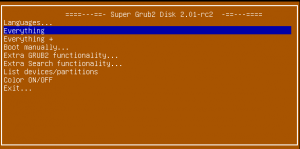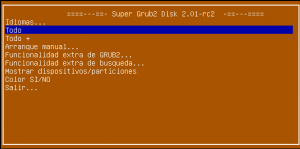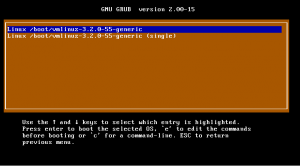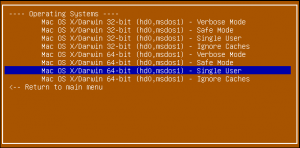I am proud to announce Super Grub2 Disk 2.00s2 stable.
Super GRUB2 Disk is a live cd that helps you to boot into most any Operating System (OS) even if you cannot boot into it by normal means.
A new stable release
The former Super Grub2 Disk stable release was 1.98s1 version and released on October 2010 (more than three years ago). So as you might guess this release has many new features and supports more Operating Systems to boot.
We are going to see which are the complete Super Grub2 Disk features with a demo video, where you can download it, the thank you – hall of fame and some thoughts about the Super Grub2 Disk development.
Please do not forget to read our howtos so that you can have step by step guides (how to make a cdrom or an usb, how to boot from it, etc) on how to use Super Grub2 Disk and, if needed, Rescatux.

Tour
Here there is a little video tour in order to discover most of Super Grub2 Disk options. The rest of the options you will have to discover them by yourself.
Features
Most of the features here will let you boot into your Operating Systems. The rest of the options will improve the Super Grub2 Disk operating systems autodetecting (enable RAID, LVM, etc.) or will deal with minor aspects of the user interface (Colours, language, etc.).
- Change the language UI
- Translated into several languages
- Spanish / Español
- German / Deutsch
- French / Français
- Italian / Italiano
- Malay / Bahasa Melayu

- Everything option to detect most Operating Systems

- Everything plus option to detect most Operating Systems also in special devices or filesystems
- Boot manually
- Extra GRUB2 functionality
- Enable GRUB2’s LVM support
- Enable GRUB2’s RAID support
- Enable GRUB2’s PATA support (to work around BIOS bugs/limitation)
- Mount encrypted volumes (LUKS and geli)
- Enable serial terminal
- Extra Search functionality
- Search in floppy ON/OFF
- Search in CDROM ON/OFF
- List Devices / Partitions
- Color ON /OFF
- Exit
- Halt the computer
- Reboot the computer
Supported Operating Systems
Basically apart from custom kernels from university students Super Grub2 Disk can autodetect and boot most every Operating System. Some examples are written here so that Google bots can see it and also to make more confident the final user who searchs his own special (according to him) Operating System.
- Windows
- Windows Vista/7/8/8.1
- Windows NT/2000/XP
- Windows 98/ME
- MS-DOS
- FreeDOS
- GNU/Linux
- Direct Kernel with autodetected initrd

Super Grub2 Disk – Detect any Operating System – Linux kernels detected - vmlinuz-*
- linux-*
- kernel-genkernel-*
- Debian / Ubuntu / Mint
- Mageia
- Fedora / CentOS / Red Hat Enterprise Linux (RHEL)
- openSUSE / SuSE Linux Enterpsise Server (SLES)
- Arch
- Any many, many, more.
- Direct Kernel with autodetected initrd
- FreeBSD
- FreeBSD (single)
- FreeBSD (verbose)
- FreeBSD (no ACPI)
- FreeBSD (safe mode)
- FreeBSD (Default boot loader)
- EFI files
- Mac OS X/Darwin 32bit or 64bit

Support for different hardware platforms
Before this release we only had the hybrid version aimed at regular pcs. Now with the upcoming new EFI based machines you have the EFI standalone versions among others. What we don’t support is booting when secure boot is enabled.
- Most any PC thanks to hybrid version (i386, x86_64, x86_64-efi) (ISO)
- EFI x86_64 standalone version (EFI)
- Additional Floppy, CD and USB in one download (ISO)
- coreboot
- i386-efi
- i386-pc
- ieee1275
- x86_64-efi
- Additional standalone versions
- coreboot (IMG)
- i386-efi (EFI)
- ieee1275 (IMG)
Supported Media
- Compact Disk – Read Only Memory (CD-ROM)
- Universal Serial Bus (USB) devices
- Floppy (1.98s1 version only)
Downloads
Recommended download (Floppy, CD & USB in one) (Valid for i386, x86_64, and x86_64-efi):

EFI x86_64 standalone version:
Floppy, CD & USB in one downloads:
- Super Grub2 Disk (Floppy, CD & USB in one) 2.00s2 [coreboot] (ISO)[Mirror #1]
- Super Grub2 Disk (Floppy, CD & USB in one) 2.00s2 [i386-efi] (ISO)[Mirror #1]
- Super Grub2 Disk (Floppy, CD & USB in one) 2.00s2 [i386-pc] (ISO)[Mirror #1]
- Super Grub2 Disk (Floppy, CD & USB in one) 2.00s2 [ieee1275] (ISO)[Mirror #1]
- Super Grub2 Disk (Floppy, CD & USB in one) 2.00s2 [x86_64-efi] (ISO)[Mirror #1]
Standalone versions:
- Super Grub2 Disk (Standalone) 2.00s2 [coreboot] (IMG)[Mirror #1]
- Super Grub2 Disk (Standalone) 2.00s2 [i386-efi] (EFI)[Mirror #1]
- Super Grub2 Disk (Standalone) 2.00s2 [ieee1275] (IMG)[Mirror #1]
Source code:
- Super Grub2 Disk 2.00s2 Source Code (TAR.GZ)[Mirror #1]
Everything (All binary releases and source code):
Hashes
In order to check the former downloads you can either download:
or you can check their contents right here.
MD5SUMS
8063a27f804c72c334ae168e6080d6d6 super_grub2_disk_coreboot_2.00s2.iso 4e7a64ceed96a072b6ccef3ea05aff00 super_grub2_disk_hybrid_2.00s2.iso 3642c487cda17d8a43aca699fd0a6f20 super_grub2_disk_i386_efi_2.00s2.iso e8d9d4efe4f29a90883f5c2ed6b45620 super_grub2_disk_i386_pc_2.00s2.iso 86a029507e5e6d24d0381515d065f634 super_grub2_disk_ieee1275_2.00s2.iso dde7dc3ce33b98af6d9721a0d9d3943d super_grub2_disk_standalone_i386_coreboot_2.00s2.img 79acccf2a79ffe35a5cc538e3e61203c super_grub2_disk_standalone_i386_efi_2.00s2.EFI b73f02be50f04cc9a97c739946890fec super_grub2_disk_standalone_i386_ieee1275_2.00s2.img b2a1fb232e0b30e4a8eeecdf33e1dbe9 super_grub2_disk_standalone_x86_64_efi_2.00s2.EFI ff122ad1f0e2fa269a3e5238bcd617cc super_grub2_disk_x86_64_efi_2.00s2.iso 7edd784638d4b46a08fa26318208c7a0 super_grub2_disk_2.00s2_source_code.tar.gz
SHA1SUMS
10d89d06ae327432b847fc2e8f95eaedb5466c63 super_grub2_disk_coreboot_2.00s2.iso 8093d72934e4c7764a30790505151fabedccb337 super_grub2_disk_hybrid_2.00s2.iso a61f21a4829dd347d8688783c4d8e8b5c41aabe1 super_grub2_disk_i386_efi_2.00s2.iso fab1116b71ebafeb18aa82a5113f3b17b951a922 super_grub2_disk_i386_pc_2.00s2.iso ed8ecfb82e9543a71d0ddc22691a954d65216376 super_grub2_disk_ieee1275_2.00s2.iso cadcd107de4ea15de34ed9ea6aa754cb3ee9df5e super_grub2_disk_standalone_i386_coreboot_2.00s2.img 8849b47da51006b8ed6afc86bf78729506ab0db2 super_grub2_disk_standalone_i386_efi_2.00s2.EFI e1fd93f4959b8a1e35ef9b44f3362ec87ba68b40 super_grub2_disk_standalone_i386_ieee1275_2.00s2.img 8a371d464974e275723c427e17834d9b24fad69b super_grub2_disk_standalone_x86_64_efi_2.00s2.EFI f973460399de09f7b96dffed89257e0de738e501 super_grub2_disk_x86_64_efi_2.00s2.iso 2f3c2e93ee5e6ea3d1fd6d33682db8f3c0286850 super_grub2_disk_2.00s2_source_code.tar.gz
SHA256SUMS
c96dadd25928f64fc51627737c36546fe439279c4fb7e05d73794b4d77a39413 super_grub2_disk_coreboot_2.00s2.iso 99f729d083fb4aaa2dff357d100f460a7120313c93cfbfa619ef83e52061b7d9 super_grub2_disk_hybrid_2.00s2.iso 3cbdd672f27b441c7296ca360ca52373a6c90b2c1b34f1ad939ee86450e7acba super_grub2_disk_i386_efi_2.00s2.iso c2a60b8cdd332c45218e3eadee88debbbfe4a6597a47ef5bb98a1221363dddff super_grub2_disk_i386_pc_2.00s2.iso 23f3259cf9156eac11c6f1d26ffdbf587ab988ae3f0496f57e333e94e9367cb9 super_grub2_disk_ieee1275_2.00s2.iso 725987d2ad3abbd8ce7e25768d2b751428525cb718a8cde2a4fd29f5149eb62d super_grub2_disk_standalone_i386_coreboot_2.00s2.img 88d56819eaad29a4b618d42d00f9625e9cd2d3cb6baf3991cbf56fb0b7478047 super_grub2_disk_standalone_i386_efi_2.00s2.EFI ad9bcb42f3971e99fbbe739ea9ca69dfd43106da5e63bcbe7843d83909273758 super_grub2_disk_standalone_i386_ieee1275_2.00s2.img 333c520a6206e050fd151b577a2e17a921e3412909ef9ed8776cc7584172dd7d super_grub2_disk_standalone_x86_64_efi_2.00s2.EFI 52ba8c5d3c576188c800a5522c785c758f46fb67e4fa3b1e28cc94c77320c0af super_grub2_disk_x86_64_efi_2.00s2.iso 4fd9326f7c224e7f06fca038f305ae9658d2c19bfe8f728b1026acc8338a6495 super_grub2_disk_2.00s2_source_code.tar.gz
Changelog (since former 1.98s1 stable release)
- New Everything option that lets you find all your Operating Systems in your computer.
- New Everything + option . It loads: LVM, RAID, PATA, USB and mounts encrypted volumes and then tries to find everything
- UI was completely redesigned
- Move all “Enable …” options to a submenu
- Add “Return to main menu” option to submenus
- Now every option from ‘Enable extra GRUB2 functionality…’ comes back to main menu after a 5 seconds delay (just in case there are any bugs)
- Show floppy and cdrom status after toggling their value. Wait 5 seconds before return to main menu
- Floppy and CDROM search toggle options go into their own submenu: Enable extra search functionality
- Boot manually submenu let’s you boot into different operating systems manually
- Added a submenu_title function to make all submenus to have the same title design
- Sleep after menu entries which print to the screen. This way you can read what these options say.
- Use gfxterm by default but allow the user to prevent the use of gfxterm by holding shift during boot. This allows the display of non-ASCII characters
- Show Super Grub2 Disk and its version at main page
- Added colours and a colour toggle option
- Now Super Grub2 Disk is built for different Target + Platform combinations. Currently is based on binary Debian packages from testing.
- (Hybrid) x86_64+efi and i386+pc
- i386 – pc
- x86_64 – efi
- i386 – efi
- x86_64-efi
- i386-efi
- i386-coreboot
- i386-ieee1275
- Additional Operating Systems detected
- Add option to detect GRUB legacy menu.lst files
- Add new option for mounting encrypted volumes (LUKS and geli)
- Added options to force floppy and / or cdrom search globally. The reason is that now floppy and cdrom search are ignored by default.
- Loopback detection now also detects: /bootisos, /boot/booisos, /BOOTISOS and /BOOTISOS directories so that FAT file name compatibility is assured
- Added support for chainloading EFI files.
- Added x86_64-efi support so that EFI files are detected and can be booted
- Added default boot loader entries for FreeBSD at OS detection script
- Added support for Gentoo kernels (genkernel) to OS automatic detection option
- Added extra boot parametres for OS X kernels
- Added new option ‘CFG – Extract entries option. This makes easier to workaround grub configuration files with zero seconds timeouts.
- Added Fedora’s path that include /boot/grub2 instead of /boot/grub on cfg detection
- Added Exit menu so that you can halt or reboot your machine.
- Added a dummy grub.cfg so that it loads main.cfg. That makes easier to reuse Super Grub2 Disk in multi OS devices.
- New translation system based on gettext and po files
- New translations
- English
- Spanish
- Added French translation. Thank you goes to Daniel_KM.
- Added Italian translation. Credits to Davide Depau
- de,fr,it and ms translations were regenerated to reflect new translation strings. They need to be checked by translators
- Development improvements
- Most Super Grub2 Disk options were rewritten as libraries to make development easier and have a consistent UI.
- Add new vmtest script to ease testing of new code. Vmtest is a bash script which will generate an SG2D iso, configure it to take input from and output to serial, then test it using kvm with kvm’s -nographic option.
- Added new AFD boot technology.
- SG2D scripts were rewritten from LUA language to new grub scripting language.
- Miscelanea fixes
- FIXED – [ Bug #18907 ] isodirs=$1 in scan_isos
- FreeBSD boot wasn’t working ok. Fixed.
- Fix gfxterm trigger. Now translation work as expected. Special characters are shown ok
- Fix OSX Boot
Finally you can check all the detailed changes at our GIT commits.
If you want to translate into your language please check TRANSLATION file at source code to learn how to translate into your language.
Thank you – Hall of fame
I want to thank in alphabetical order:
- bfree (Niall Wash): For his work in rethinking how Super Grub2 Disk grub script might be rewritten although we never used that code. For adding code for EFI chainloader, helping on building and testing Super Grub2 Disk EFI releases.
- Jordan_U (Jordan Uggla) (jordan.uggla AT gmail DOT com): For his work in rewriting Lua Super Grub2 Disk into new Grub2 scripting. Also for his work in translation system based on gettext and po. And also I want to thank him for all this work in Super Grub2 Disk in many many ways.
- nox (Juergen Lock) (nox AT freebsd DOT org): For his work in fixing *BSD boot entries and helping adding new *BSD boot entries and testing.
- Smx (Stefano): For his Mac OS X / Darwin boot fixes and testing. He has also worked in redesigning some of the menues and probably his work will be included in next Super Grub2 Disk versions. He has also worked in a keyboard selection menu on his own too. That will be also included in next versions.
The person who writes this article is adrian15 and is proud of being responsible among other things for the rewriting of options as if they were libraries. And also for the User Interface (UI) complete redesign.
And I cannot forget about thanking bTactic, the enterprise where I work at and that hosts our site.
Some thoughts about Super Grub2 Disk development
Stable Super Grub2 Disk being very old
The last four years I have been focused on bTactic, the enterprise where I work and also in Rescatux. On february or march of this year (2014) I decided to release an stable Rescatux release. But this stable Rescatux release did not make sense without an stable Super Grub2 Disk base.
Another fact was that the newest stable Super Grub2 Disk was very old. More than this Jordan Uggla, which was very active two years ago seemed not very active lately.
So… there was an actual need for releasing stable Super Grub2 Disk.
Amazing Super Grub2 Disk development
One thing that I have liked about this recent Super Grub2 Disk development apart from upstream Grub2 improvements is the many people that have contributed to it.
Usually I was developing Super Grub2 Disk alone with the great help of Jordan Uggla which deals with upstream Grub2 and testing (he did the vmtest script) much better than I.
But now a few people have come around helping in various ways. Sometimes it was about testing EFI (bfree), sometimes it was about fixing FreeBSD (nox) which I don’t use myself so I cannot test it. And finally there was Smx which focused on Mac OS X / Darwin boot entries and testing but that promises a lot because in his own supergrub2 repo he has added some new features: beautify disk / partition menu and keyboard layout menu.
So to all of you, even if you are already mentioned in Hall of fame: Thank you!
New features to come
I still check old Super Grub Disk for new features. One I would like to implement is the hard disk live swap although it’s only useful for old computers. But I won’t probably implement it.
The other features are based on Smx work:
- Boot individual partitions
- keyboard layout menu (so that you can write a french, spanish, or whatever keyboard layout in grub shell).
Another apparent great feature is using Grub 2.02 capabilities for releasing a floppy image that fits into a floppy (not like the current ones that are floppy compatible but as you know there aren’t 12 MB size floppies).
I have even thought about adding a bunch of Linux kernels (and initrd) into Super Grub2 Disk so that you even boot into your system even when you don’t have a kernel, but I’m not sure about this move.
It would be interesting also to apply into Distrowatch because now Super Grub2 Disk would have not only a Grub kernel but also a Linux kernel… but you know, having a Linux kernel and just using it to boot another distribution I don’t think it applies as a distribution to be listed on Distrowatch :).
What I don’t plan to support at all is secure boot.
Rescatux development
As I have said the stable Super Grub2 Disk release was only a mere excuse for releasing an stable Rescatux release. Now I’m thinking about not making stable 0.31 based on Razor-qt and trying to use LXQT instead. So to release an 0.32.
Not sure what I’m going to do. I think it’s going to depend on third party razor-qt ppa status.
Anyways I’m quite busy at work so you won’t probably see neither a Super Grub2 Disk nor a Rescatux release in the next months.
(adrian15 speaking)

11 thoughts on “Super Grub2 Disk 2.00s2 released”